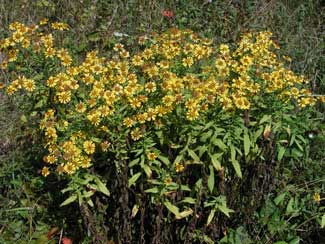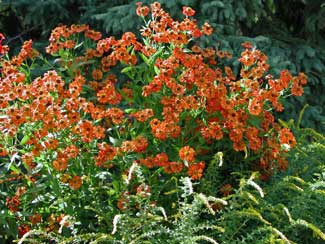Resource Library
Plant of the Week: Sneezeweed
The University of Arkansas System Division of Agriculture does not promote, support or recommend plants featured in "Plant of the Week." Please consult your local Extension office for plants suitable for your region.
Plant of the Week
Sneezeweed
Latin: Helenium autumnale

I once read a quote I wished I’d written down from a snobby English gardener who essentially said “no serious gardener would ever grow any kind of daisy.”
Though Englishmen are often considered great gardeners, such sweeping generalizations should be taken for what they are – nonsense. One of our native plants and yes – a member of the daisy family – is sneezeweed (Helenium autumnale) that should be used in more Arkansas gardens.
The genus Helenium includes about 40 species of New World annuals and perennial forbs ranging throughout much of North America. H. autumnale occurs from New England to Northern Mexico and is the most often cultivated of the group. Wild plants are perennial and grow from 3 to 5 feet tall with a spread equal their height. Leaves are lanceolate that join with the winged portion of the stems.
Sneezeweed flowers are 2 to 3 inches across with a rounded yellow or brown ball of disc florets surrounded by wedge shaped ray florets that end in three rounded lobes. The ray flowers are generally held at right angles to the stems in the cultivated forms but in wild plants often droop downward. Flower colors range from yellow to orange-brown.

The common name sneezeweed comes from the Native American use of the dried leaves to create a kind of snuff that made the user sneeze. This, as anyone who has experienced a really good sneeze realizes, was thought to expel evil spirits from the head. The showy flowers are insect pollinated and therefore pollen is relatively large and sticky so is not normally associated with hayfever.
Sneezeweed has been cultivated in gardens for at least a century but its popularity during that period has ebbed and flowed with time. It seems to be regaining popularity in recent years as Dutch hybridizers have been introducing dwarf selections that grow about two feet tall and wide. It is more commonly seen in northern and Midwestern gardens than in the south.
Sneezeweed is used as an addition to the summer border or can be grown in large containers for color on the patio from late summer into fall. It is best in rich, somewhat moist soils where it receives at least six hours of full sun a day. Unless one of the new dwarf forms is planted, most Heleniums benefit from being cut back to about 8 inches tall in mid-June to keep their flowering height in the 2 to 3 foot tall range. Plants are winter hardy in zones 4 through 8. As a perennial Helenium tends to be somewhat short-lived, seldom lasting more than three or four years unless plants are lifted and reset.
By: Gerald Klingaman, retired
Retired Extension Horticulturist - Ornamentals
Extension News - August 9, 2013
The University of Arkansas System Division of Agriculture does not maintain lists of retail outlets where these plants can be purchased. Please check your local nursery or other retail outlets to ask about the availability of these plants for your growing area.